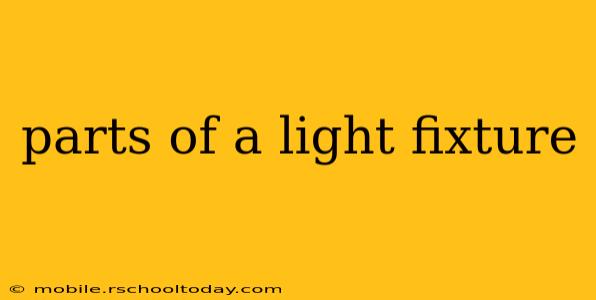Choosing the right light fixture can dramatically impact the ambiance and functionality of any space. Understanding the different parts of a light fixture is crucial, whether you're installing a new one, repairing an existing one, or simply want to appreciate the intricacies of lighting design. This guide breaks down the key components, answering common questions along the way.
What are the main parts of a light fixture?
The fundamental components of a light fixture vary depending on the style and type (e.g., pendant, flush mount, chandelier), but most include these core elements:
-
The Housing/Body: This is the main structural element, often made of metal, plastic, or glass, providing the fixture's shape and aesthetic appeal. It houses the electrical components and protects them from damage.
-
The Socket(s): This is where the light bulb is inserted and connected to the electrical circuit. Different fixtures have varying numbers of sockets, accommodating multiple bulbs. The type of socket (e.g., Edison screw, bayonet) determines the type of bulb that can be used.
-
The Wiring: This crucial element connects the fixture to the power source. Safe and correct wiring is paramount for both functionality and safety. It includes the wires connecting the fixture to the house wiring and those connecting the sockets to the power supply within the fixture.
-
The Lamp/Bulb: This is the light source itself. Different bulb types (incandescent, LED, fluorescent, halogen) offer varying light output, energy efficiency, and lifespan.
-
The Mounting Hardware: This includes the components that secure the fixture to the ceiling or wall, such as mounting brackets, screws, and possibly a junction box. The type of hardware depends on the fixture's design and installation location.
-
The Shade/Diffuser/Globe: (Often optional) This component softens and directs the light output, influencing the overall illumination and ambiance. Shades come in diverse materials, shapes, and sizes, each impacting the light's aesthetic effect.
What are the different types of light fixture mounts?
Light fixtures are mounted in various ways, each suited to specific locations and aesthetic preferences. Common mounting types include:
-
Flush Mount: These fixtures sit close to the ceiling, ideal for rooms with low ceilings.
-
Semi-Flush Mount: These fixtures hang slightly below the ceiling, offering a bit more visual interest than flush mounts.
-
Pendant: These fixtures hang from the ceiling via a chain or cord, providing a more dramatic look and adjustable height.
-
Surface Mount: These fixtures attach directly to the wall or ceiling's surface.
-
Recessed: These fixtures are installed within the ceiling itself, providing a clean and minimalist look.
What is the difference between a fixture and a luminaire?
While often used interchangeably, there's a subtle distinction: "Fixture" is a more general term for any device that holds a light source, while "luminaire" is a more technical term typically used in professional lighting design and usually refers to a more sophisticated or custom-designed lighting solution.
How do I choose the right light fixture?
Selecting the right fixture involves considering several factors:
-
Room Size and Ceiling Height: Larger rooms benefit from larger fixtures, while low ceilings require more compact designs.
-
Lighting Style: Different fixture styles create different ambiances (e.g., minimalist, traditional, modern).
-
Light Output and Color Temperature: Consider the amount of light needed and the color temperature (warm, cool, or neutral) to create the desired atmosphere.
-
Bulb Type: Choose energy-efficient bulbs like LEDs for long-term cost savings and environmental benefits.
How do I safely install a light fixture?
Light fixture installation should always be handled by a qualified electrician unless you have extensive electrical experience. Incorrect wiring can be hazardous. If attempting DIY installation, always turn off the power at the breaker before working on any electrical components.
Understanding these components and factors enables you to make informed decisions when selecting, installing, or repairing light fixtures, enhancing both the functionality and aesthetic appeal of your home. Remember, safety always comes first, so consult a professional if you are unsure about any aspect of electrical work.
